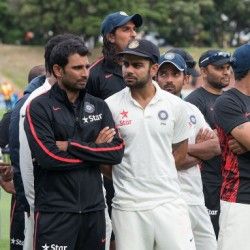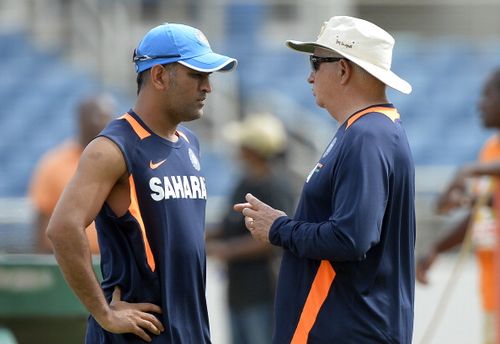
Defensive tactics hurting Team India

Lack of attacking intent hurting India
This is not the first time India have gone through a Test series winless after having the opponents on the ropes. This problem started right from the England series in 2011.
In the current tour, they bowled out New Zealand for 192 in the first innings and gained a good lead of 246. But the Indian team failed to capitalise on the advantage as the hosts exploited India’s weakness once again. India’s weakness is that they run out of ideas if a partnership starts building. That’s exactly what happened as record stand for sixth-wicket ended India’s hopes of levelling the Test series.
So, what could be the problem for India? When India toured England in 2011, they started the Test series as a No.1 ranked team. They also had their chances to win in the first couple of Tests.
In the first Test at Lord’s, after Zaheer removed the openers in the first session, England were on the backfoot. Cook was lbw to Zaheer and Strauss was caught after getting a top edge at fine leg. Dhoni was also attacking with three-slips, two gullies and a man at short-point.
However, after Zaheer Khan limped back with injury in the 41st over, Dhoni was short of a bowler. He failed to find a bowler who could be a partnership breaker. From there on, England started to build an innings and posed a lot of questions for MS Dhoni. MS Dhoni soon spread his field and didn’t have an attacking mindset. At the time, he was satisfied with slow-scoring rate by England.
If the team’s premium pacer is missing, why Dhoni didn’t attack with other bowlers? Praveen Kumar was the other seamer in the line-up. He was swinging the ball really well. He was also deriving lateral movement off the surface. When Praveen is posing some problems, the close-in fielders play an important role.
But Dhoni had just the two slips in place and rest of them were at backward point, cover point and mid wicket. This field placement makes no sense as Praveen was an attacking bowler. He, however, managed to pick up wickets by bowling stump-to-stump. India eventually lost the Test match where they could have won comprehensively if they had England on the ropes in first innings.
Another match where India could have won was at Trent Bridge. Dhoni once again opted to field given the conditions at Nottingham. India’s seamers made early inroads and had the England team wobbling at 124/8. However once Stuart Broad started dominating, MS Dhoni lacked ideas and his pacers were constantly missing the line and lengths. The Indian pacers were providing too much room for Broad to free his arms, and were also drifting the ball towards leg side constantly.
Three conclusions can be drawn from the two instances. India’s pacers lack ideas and patience if a batsman is settled. MS Dhoni lacks aggression in Tests, and also runs out of ideas to get rid of a settled batsman. He didn’t do anything that would earn him a wicket. He and his pacers waits for the opposition to make a mistake. Also, the Indian attack is dependent on conditions, and if the condition is not in favour of India’s bowling attack, they would go for plenty of runs.
Who is behind this strategy? Obviously, the coach Duncan Fletcher is to be blamed for India’s debacle overseas. His defensive approach has not worked out even in a single Test match. You may argue that India bowled out New Zealand for 192 in first innings of second Test. But one has to admit that it was typical bowling wicket. When he took over as the coach of Indian team, he totally changed every player’s mindset.
Fletcher told Virender Sehwag to adapt to Test format and bat according to the situation. Sehwag soon lost his form. In India’s tour of West Indies in 2011, Fletcher told Suresh Raina “If we’re chasing around 220, don’t push for big shots or be aggressive from 20-40 overs. Should rotate the strike and take stock after 40th over”. India pulled-off couple of tense wins against West Indies in a small chase. If the coach could have given the freedom to the players, India would have won comprehensively and the young team would have gained the confidence.

Duncan Fletcher – How much is he responsible for the decline of Indian cricket?
Duncan Fletcher’s idea of consolidating in the middle overs and attacking bowlers at the end does not make sense. You need to adjust the game according to the situation and the surface which Fletcher is not thinking. His aim is to not lose wickets in the middle overs which is not a bad idea. But he has to understand that scoring at a brisk-rate is more important to put pressure on the fielding team.
Even in the Test series in Australia in 2012, Duncan Fletcher changed the technique of some of the Indian batsmen. He told the opening batsmen Virender Sehwag and Gautam Gambhir to survive the new-ball rather than going for shots. Yes, his point can be agreed to some extent. But restricting the player from playing his natural game is not a good idea from the coach Fletcher.
The openers were trying to survive, but they also failed to punish some loose deliveries. The openers didn’t make an impact. When the openers were dismissed in the second innings of the first Test, the score read only 39 runs off 12 overs. This in turn added the pressure on middle order to take India back into the position of strength. Fletcher fails to understand the difference between 17/2 in seven overs and 100/2 in 21 overs.
His idea was also seen in the current tour of New Zealand. When India had New Zealand wobbling at 30/3 in the first Test, the pacers should have showed more intent and attacked. They rather became complacent and when Kane Williamson started handling the Indian seamers well, the pacers lacked innovative thinking. They didn’t bring variations, and also didn’t get the field that they want. MS Dhoni removed the slips and positioned them in front of square, midwicket and an unwanted man at square leg, when the line and length is around off-stump.
The conclusion that be drawn is India need to show more intensity in Test cricket. Attacking is the best option to dismiss the batsmen especially in a seamer friendly wicket. Also when the surface is offering nothing for seamers, the spinner should bring in variations in length to deceive the batsmen. For that, Dhoni should have more close-in fielders unless the batsman has crossed half-century.
It’s going to be a hard work for MS Dhoni and co. when they travel to England in the month of June. They, however, would have a lot of confidence behind them as they performed better in New Zealand series. For them to succeed in England, the players should be allowed to play their natural game.
For instance, Dhawan has gained some improvement and is showing great intensity. Virat Kohli has been the consistent man and scored a beautiful century at Wellington to draw the second Test. Finally, the bowlers need to come up with strategies against each batsmen. How to remove a settled batsmen? They should also think in that angle and come up with effective plan for the tour of England.
Can India bounce back in England? Will the Indian players be allowed to play their natural game? Will MS Dhoni learn from his mistakes? Lots to look forward for.